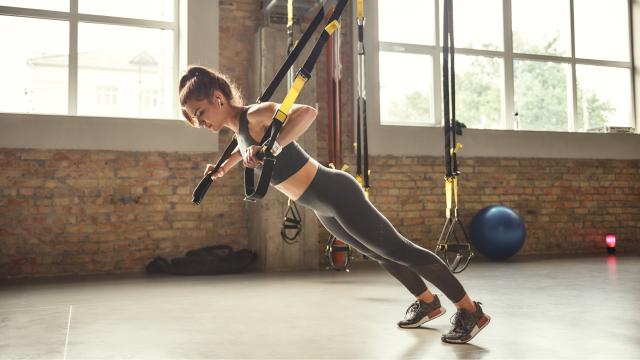Suspension trainers are great for home workouts and for travelling, but you’ll also see the (often) yellow and black straps dangling from a pullup bar at the gym. What are they even good for, if the machine and dumbbell alternatives are right there? Let’s take a tour of some of the exercises that are actually best done with a suspension trainer.
Many of these can also be done with gymnastics rings, but the reverse isn’t true. Rings typically hang from two separate straps, while a TRX setup will have both straps connected to the same anchor point. That means they’re awkward for ring dips, but there are still plenty of great exercises you can do.
Ring rows
Crossfitters call these “ring rows” and do them with gymnastics rings; TRX users often call them “low rows.” Whatever you call them, these are a convenient, easily-adjustable alternative to pullups. Lean back slightly for the beginner version; bring your feet forward so your body is almost horizontal for a tougher challenge.
Pushups on the handles
Turn an ordinary pushup into a challenge for your stabilizer muscles by putting your hands on the suspension trainer’s handles instead of on the floor or an elevated surface. As with ring rows, you can adjust the difficulty by changing your body position: the more vertical you are, the easier it is.
Assisted pistol squats
If you’re working your way toward one-legged “pistol” squats, a suspension trainer is one of the exercises that can allow you to hone the movement. Hold on to the handles and sit back into your squat, then pull on the handles to stand back up. Pair this with un-assisted step-ups and balance exercises, and you’ll be well on your way.
Beginner squat
Maybe you’re not ready for a pistol yet; maybe you’re still trying to figure out air squats. Hold the handles and sink back into the squat. This can help if you have a tendency to pitch forward as you squat, or if you’ve never quite managed to squat deep enough. Sinking back lets you try out that body position in a safe way. And even if you can already do a regular squat, you may find this to be a great warmup stretch for your ankles.
Unstable plank
Planks get a lot harder when you challenge your core muscles to hold you steady. This is one of the better uses of instability training, in my opinion. Put your feet in the handles and your hands on the ground, and try to hold a plank position. It’s harder than it looks!
Y fly
This is a version of ring rows that challenges your shoulder muscles in a way that’s similar to what you can do with dumbbell raises. It also works your upper-back muscles in a similar way as a row, making it a great accessory for almost any strength program. Once you’ve mastered the Y fly, try different arm positions for what are called T/Y/I pulls.
Triceps press
This combines a tricep extension with a bonus core challenge as you hold your body in a plank position. I wouldn’t say these are better than other tricep exercises, just a different option that you can rotate in with your dumbbell tricep extensions and your cable tricep pushdowns.
Bicep curl
This is the partner to the tricep press, and you can superset the two together for a great arm finisher. Keep your core tight and pull yourself toward the handles.
Pike
For a killer core exercise, try this one. Put your feet in the handles, and then bring them toward you by only bending at the hips. (You can also do this exercise with your shins on a stability ball. It’s tough.)
One arm row
We saw ring rows earlier, but if those aren’t hard enough for you, try the one arm version. This makes your arm pull more weight, and it also creates a stability challenge for the rest of your body.
Hamstring curls
For this exercise, you’ll put your feet in the handles again, but this time they’re pointing toward the sky. Keep your shoulders on the ground and pull your feet toward you.

Leave a Reply
You must be logged in to post a comment.